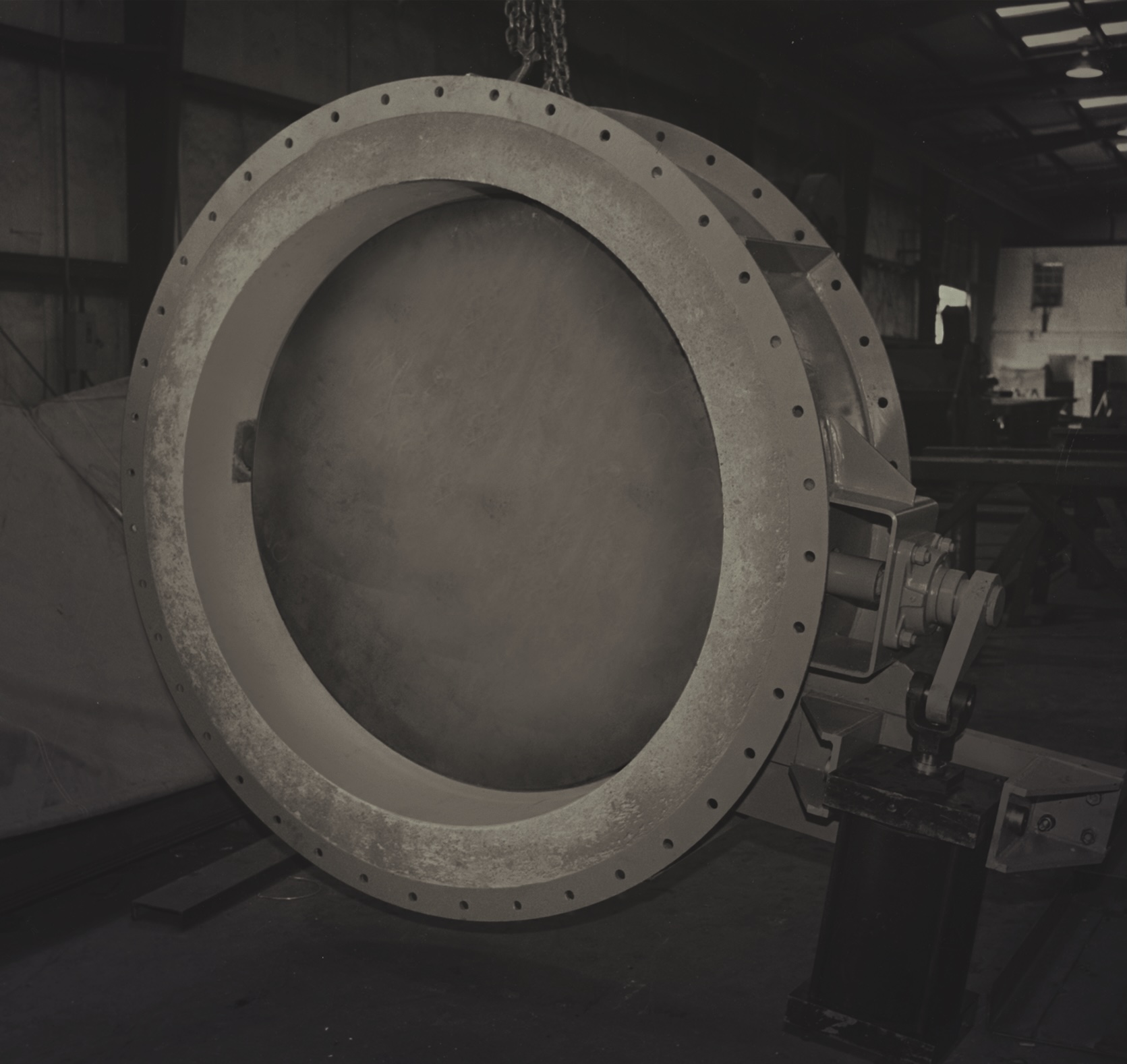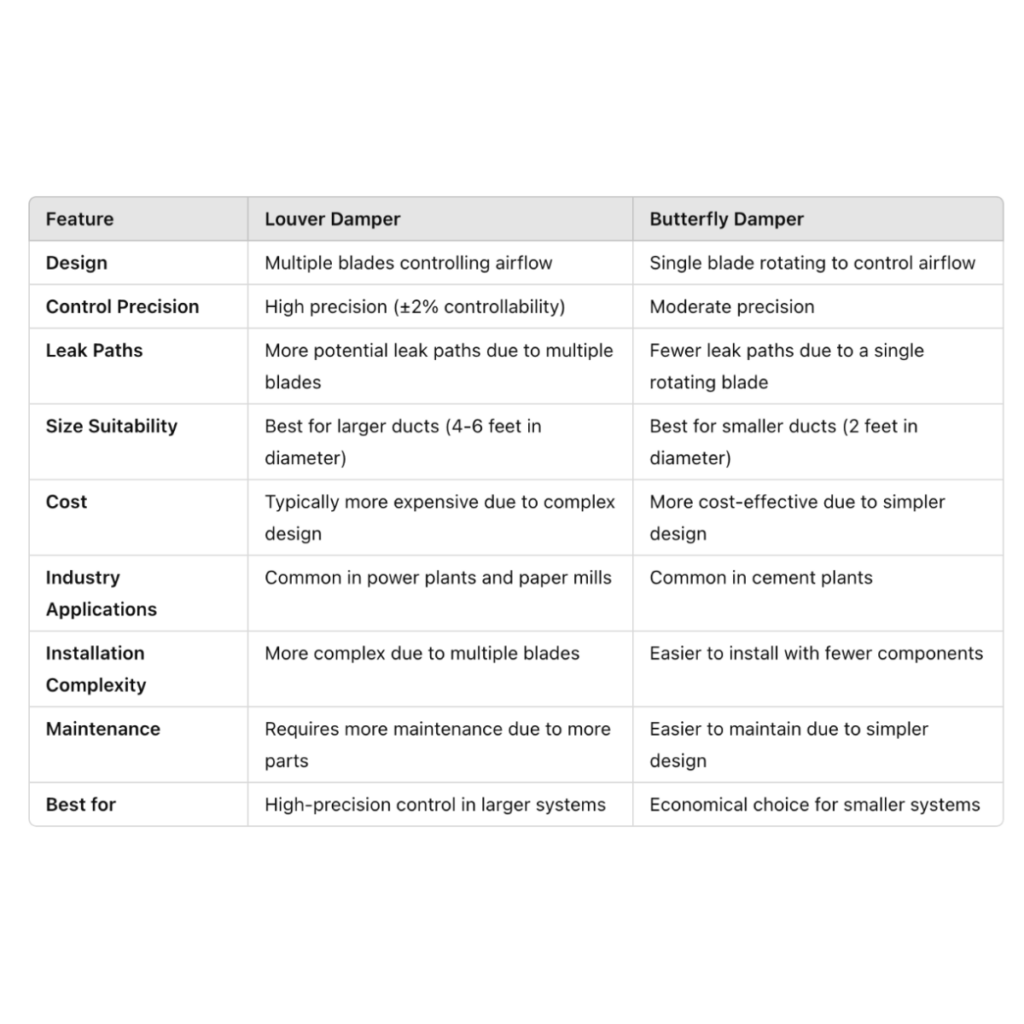In a recent conversation, our resident expert in Manufactured Dampers, Shane Glidewell, compares and contrasts Louver and Butterfly Dampers, discussing their unique characteristics, industrial applications, and industry-specific uses. This blog analyzes key technical aspects of Louver and Butterfly Dampers, focusing on control precision, shutoff capabilities, cost differences, and installation best practices.
What Are Louver Dampers?
Louver Dampers feature multiple blades, providing precise airflow control with ±2% accuracy, but this design can also lead to more potential leak paths. The key advantage of Louver Dampers lies in their controllability, making them ideal when precision is a priority but is not the more economical choice between the two dampers.
What Are Butterfly Dampers?
Butterfly Dampers have a single, round blade that pivots on a central hinge to regulate airflow. A Butterfly Damper is a less advanced version of the Louver Damper in size, controllability, and fewer leak paths but is an economical choice. Known for its compact and simple design, it is great for a limited space. When closed, the blade can press against a seal to create a tight shutoff, preventing air leaks.
Find your air leaks, and fix them, too.
Which Industrial Damper is Right for You?
It depends on several factors, like the environment, the industry, airflow control, and budget. The key question you need to ask yourself is, “Would you rather shut your flow off, or do you want to control it more?”
In a cement plant, shutoff is important but the volume of air is not a critical factor unlike power plants and paper mills. “The Louver Damper is more commonly used in power and paper mills, while the Butterfly Damper is preferred in cement plants due to the different process requirements of each industry,” explains Glidewell.
For instance, in a two-foot diameter duct, installing multiple blades is not practical, making a Butterfly Damper a better option. However, for larger ducts, like 4-foot or 6-foot diameters, it’s much more feasible to incorporate multiple blades. In cases where cost is a major consideration, a Butterfly Damper can be a more economical alternative to a Louver Damper. Louver Dampers typically provide a 2.5-3% shutoff, whereas Butterfly Dampers offer less than 1% shutoff, making them more suitable for applications requiring tight shutoff.
Louver Dampers have multiple blades, offering more precise control of airflow (±2% controllability) but creating more potential leak paths. Butterfly Dampers have a single blade, making them more economical and better for shutoff applications, with controllability of around ±20%.
Key Differences Between Louver Dampers and Butterfly Dampers
This table summarizes the key technical differences and industrial applications of Louver and Butterfly Dampers, helping to identify the best option for your specific air handling needs.
Durability and Maintenance:
Butterfly Dampers typically have a longer life span in comparison to the Louver Damper. This is due because of the design of the single blade on the Butterfly Damper causing less strain. Whereas the Louver Damper has multiple blades, which can experience wear potentially causing leakage over time. In terms of maintenance, the Butterfly Damper is easier to maintain due to fewer parts but still requires maintenance on seals and bearings.
Vulnerability to Wear:
It all depends on the environment and harsh weather conditions the equipment is working under. However, Butterfly Dampers hold up better meaning less regular maintenance if the environment is consistent with low-stress operations. The Louver Damper is best suited in more stable conditions, meaning milder temperatures and less corrosive environments. The Butterfly Damper can hold up in stable environments but may struggle in extreme weather.
Turnkey Installation
The lead times for custom-engineered dampers are relatively similar, with Butterfly Dampers typically having a slight advantage of about one to two weeks. Butterfly Dampers generally have a lead time of 6 to 8 weeks, while Louver Dampers take around 8 to 9 weeks due to their more complex design, which involves multiple blades. Despite this slight difference in lead time, the installation process for both dampers is essentially the same.
“Approximately 90% of damper installations are automated, with manual operations being rare exceptions. The automation technology for both dampers has been in use for over 20 years,” explains Glidewell.

ProcessBarron Dampers
All custom dampers are designed, manufactured, shop-assembled, and tested in-house at our Alabama facilities. Field crews are available for complete turnkey installation, equipment start-up, on-site inspections, and detailed evaluations of your current damper needs. Technical assistance and custom-designed damper specifications are provided through our sales and engineering departments. Our expertise includes developing new applications, retrofitting and upgrading equipment into existing spaces, and providing readily available parts for emergencies.
Custom-Engineered Dampers
Partner with Us
Addressing air flow and leakage is a key aspect to keeping your plant running smoothly. Enhance your air handling efficiency and work with experts from concept to completion. Our team at ProcessBarron will custom-design your dampers. Find a ProcessBarron sales representative or contact us today to assist in your air handling needs. Handle Everything Better.



